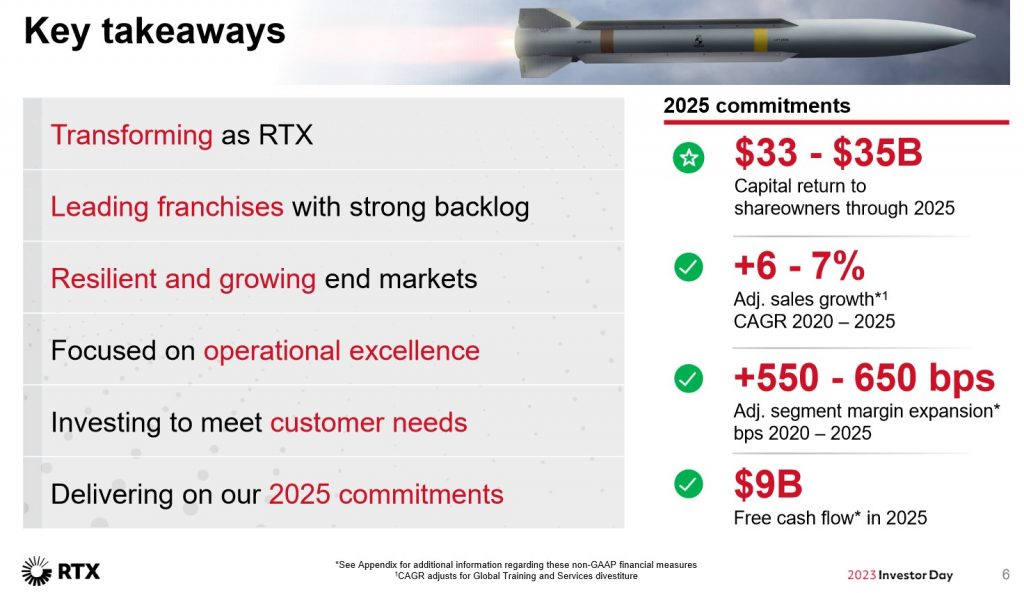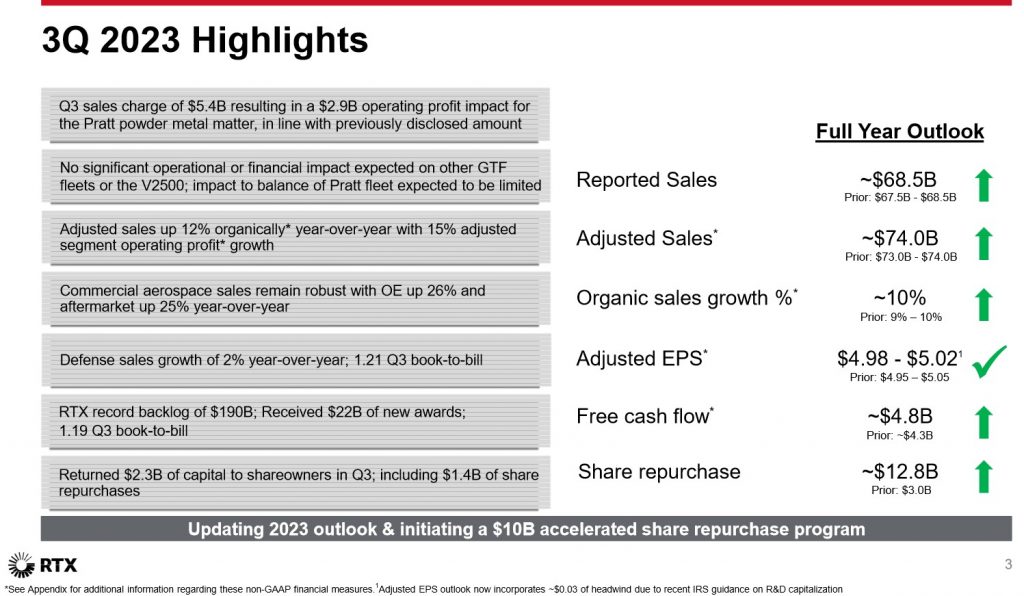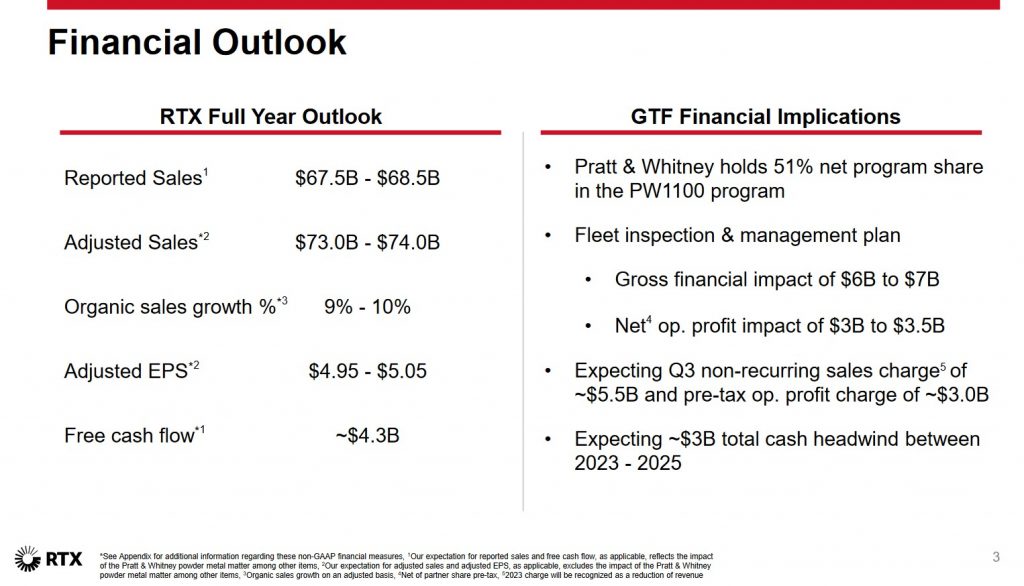Contents

On July 25, RTX Corporation (RTX) surprised the investment community when it disclosed that its Pratt & Whitney (P&W) operating segment identified microscopic contaminants in a metal used in part of the Geared Turbofan (GTF) engines that power Airbus' popular A320neo jets. RTX's share price plunged following this announcement and based on my analysis I viewed this as an opportunity to add to my exposure; I disclosed my purchase in this July 29 post.
On September 11, RTX held a Pratt & Whitney GTF Fleet Update Conference Call to update the investment community. RTX's share price plunged further and based on my analysis, I deemed its valuation to be too attractive to pass up. I, therefore, disclosed my decision to acquire additional shares in this September 12 post.
I now briefly revisit this holding following the release of its Q3 and YTD2023 results on October 24.
Business Overview
Investors unfamiliar with RTX should review the company's website and Part 1 Item 1 within the 2022 Form 10-K. Additional information is also found on page 9 of 182 in the Q3 2023 Form 10-Q.
The World's Largest Jet Engine Manufacturers
GE Aerospace, Rolls-Royce, and Pratt & Whitney are major players in the jet engine market. GE Aerospace holds the title for the most powerful commercial engine, while Rolls-Royce powers over 35 passenger aircraft types.
Pratt & Whitney is known for its JT8 and JT9 engines, with its revolutionary geared turbofan (GTF) engines powering popular aircraft like the Airbus A220 and A320neo family.
CFM International, a partnership between GE Aerospace and Safran Aircraft Engines, is famous for its CFM56 series engines. These engines power a significant portion of the Airbus A320 family. The company is also developing the CFM LEAP engine for next-generation narrowbody jets.
Sale of Collins' Actuation And Flight Control to Safran
In my July 29 post, I touched upon RTX's announcement that it had reached an agreement with France's Safran S.A. to divest its Collins’ actuation business to Safran. Safran is a French multinational company that designs, develops and manufactures aircraft engines, rocket engines as well as various aerospace and defence-related equipment or their components.
This transaction is expected to close in the second half of 2024 with proceeds from the transaction being ~$1.8B.
As part of the deal, Collins will become a customer for 25% of Safran’s new activity, typically for nacelle actuators.
Safran / GE Aerospace Engine Issues
While RTX has engine issues, Safran and its US engine partner GE Aerospace have their own issue. They allege that AOG Technics, a parts distributor, sold thousands of parts for the world's most-sold jet engine, built by Safran's and GE Aerospace's CFM International joint venture, using false certification documents.
While AOG Technics has told a British court it is cooperating fully with investigations by the companies and regulators, the head of Safran has called for a criminal investigation.
Bogus parts have plagued the aircraft industry for years. The presence of uncertified parts inside the high-tech jet engines, however, has raised concerns and triggered a race to track them down.
After an analysis of the documentation provided by AOG Technics, CFM has identified 180 falsified documents, covering 124 part numbers. Half of the 145 engines involved have been repaired and the other half will be treated shortly.
Sale of Cybersecurity, Intelligence and Services Business
On October 18, 2023, RTX entered into a definitive agreement to sell its Cybersecurity, Intelligence and Services business within the Raytheon segment for ~$1.3B to an unnamed buyer. The closing of the transaction is subject to regulatory approvals and other customary closing conditions.
2023 Investor Day
In my July 29 post, I provided a link to the details RTX presented at its June 19, 2023 Investor Day. I provide them again for ease of reference with the following being the key takeaways.
Financials
Q3 and YTD2023 Results
I provide links to RTX's Q3 Form 10-Q, Earnings Release, and Earnings Presentation released on October 24 so you can readily access the information to conduct your assessment.
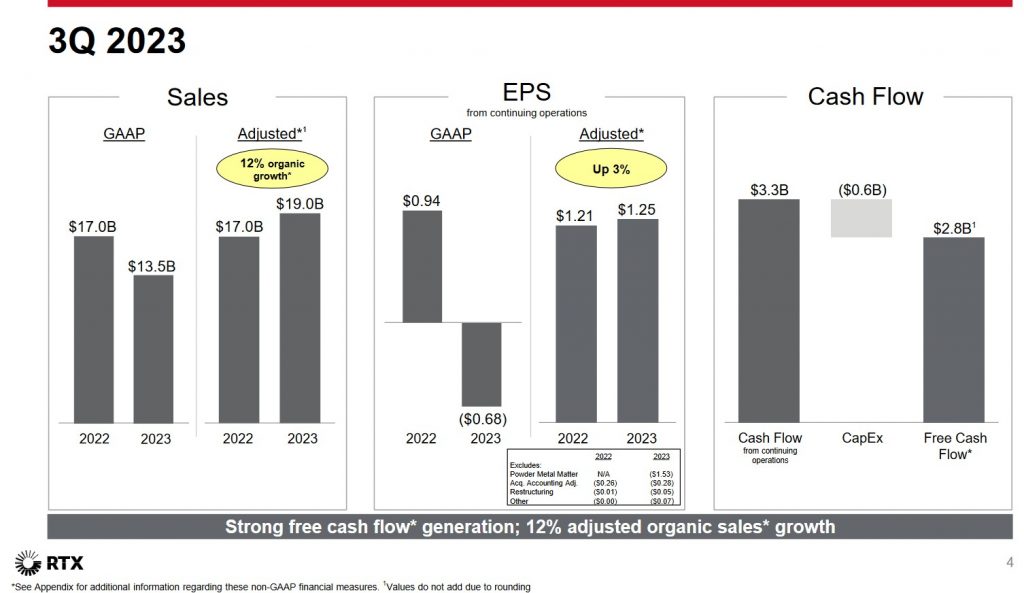
Source: RTX - Q3 2023 Earnings Presentation
RTX's total backlog was ~$190B and ~$175B as of September 30, 2023 and December 31, 2022, respectively. This includes a defense backlog of $75B and $69B as of September 30, 2023 and December 31, 2022, respectively. RTX's defence operations consist primarily of the Raytheon business and operations in the defence businesses within RTX's Collins and Pratt & Whitney segments.
Defense bookings were ~$12B and ~$12B for the quarters ended September 30, 2023 and 2022, and ~$37B and ~$34B for the nine months ended September 30, 2023 and 2022, respectively.
RTX continues to expect strong international and domestic demand, which has already driven a 2023 YTD book-to-bill of 1.22 and a record defence backlog that will continue to convert to solid growth over the next several years.
While inflation has begun to moderate, there are still pockets that remain persistently high within RTX's manufacturing base. Expectations are that this will continue into 2024. Given this, RTX will continue working on all the mitigation actions in place in the past 2 years, and it will implement additional strategic initiatives to offset the additional inflationary pressures expected in 204.
FY2023 Outlook
RTX's current FY2023 outlook is reflected above. For ease of comparison, the following is RTX's FY2023 outlook when it provided its Pratt & Whitney GTF Fleet Update on September 11.
The current FY2023 Free Cash Flow (FCF) outlook is $4.8B (raised from $4.3B); RTX has generated $2.752B in the first 3 quarters.
Management continues to expect sales to be up low to mid-single digits.
While the supply chain continues to improve, RTX continues to have productivity and mix challenges and higher production costs. As a result, the adjusted operating profit is being lowered from $0.125B - $0.175B to $0.025B - $0.075B versus the prior year.
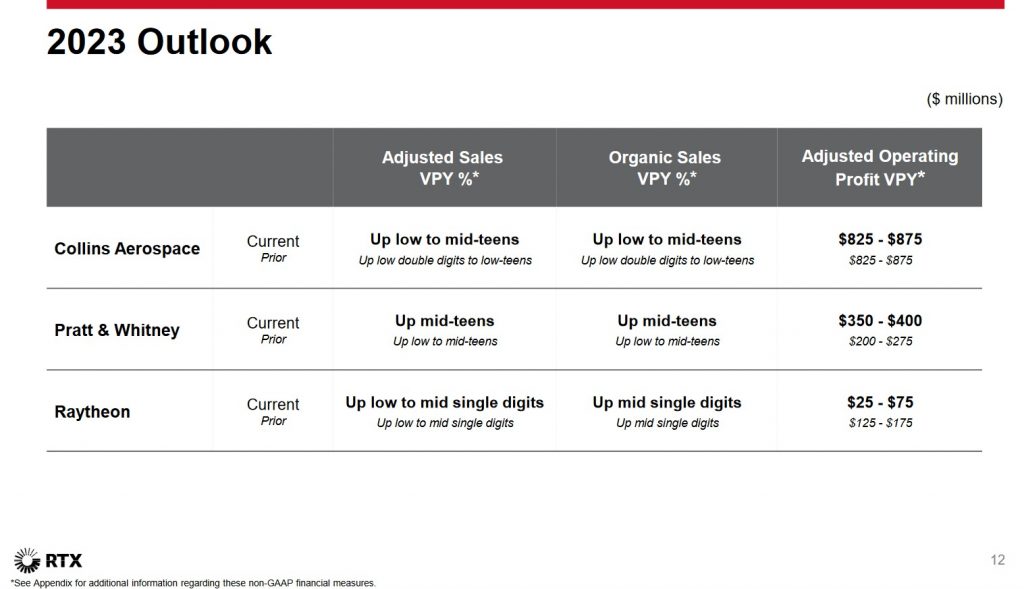
Source: RTX - Q3 2023 Earnings Presentation

Source: RTX - Q3 2023 Earnings Presentation
RTX will provide its FY2024 outlook when it releases its FY2023 financial results. For now, however, management anticipates another year of solid growth in organic sales, segment operating profit, margin and free cash flow (FCF). The level of FCF, however, will be tempered by the step-up in cash impacts associated with the powder metal matter as well as some headwind from cash taxes related to R&D.
Credit Ratings
The average maturity of RTX's long-term debt at the end of Q3 is ~14 years. Details of RTX's long-term debt commence on page 13 in the Q3 2023 Form 10-Q. This, however, will change in the coming quarters as RTX will be arranging long-term debt to replace the $10B bridge loan being used to fund the accelerated share repurchase program (ASR) (see Share Repurchases section below).
Moody's currently assigns a Baa1 rating to RTX's senior unsecured domestic currency debt with a negative outlook. This is the top tier of the lower medium-grade category.
This rating defines RTX as having an ADEQUATE capacity to meet its financial commitments. However, adverse economic conditions or changing circumstances are more likely to lead to a weakened capacity to meet its financial commitments.
S&P Global continues to assign an A- rating with a negative outlook. This rating is one notch higher than that assigned by Moody's and is the lowest tier of the upper-medium grade category.
S&P's rating defines RTX as having a STRONG capacity to meet its financial commitments. However, it is somewhat more susceptible to the adverse effects of changes in circumstances and economic conditions than obligors in higher-rated categories.
Both ratings are investment grade and are acceptable for my purposes.
Dividend and Dividend Yield
When I wrote my July 29 post, I disclosed the purchase of an additional 100 shares at $85.67. Using this purchase price and the $0.59 quarterly dividend (see dividend history), the dividend yield was ~2.75%.
Following the September 11 Press Release, I acquired an additional 100 shares @ $78/share. Based on RTX's historical dividend increases, I envisioned the declaration of an increase from $0.59 to $0.63 in April.
With shares now trading at ~$79.15, I project the next 4 quarterly dividend payments will total $2.48 ((1 x $0.59) + (3 x $0.63)) thus resulting in a ~3.1% forward dividend yield.
RTX's weighted average number of issued and outstanding shares in FY2010 - FY2022 (in millions rounded) is 923, 907, 907, 915, 912, 883, 826, 799, 810, 864, 1,358, 1,509, and 1,486. The significant increase in RTX's outstanding shares in FY2020 is primarily due to the merger of United Technologies Corporation's aerospace business and Raytheon Company on April 3, 2020.
In the first 9 months of FY2023, RTX repurchased ~29.297 million shares for $2.587B (~$1.4B in Q3); the diluted weighted average number of shares outstanding in Q3 2023 is 1,448.1.
Management is of the opinion there is a significant discount between the intrinsic value of RTX and the current stock price. As a result, on October 21, 2023, RTX's Board authorized a share repurchase program for up to $11B of RTX's common stock, replacing the previous program announced on December 12, 2022. This share repurchase authorization is inclusive of the authority to enter into a $10B ASR. The FY2023 share repurchase spending has been revised to ~$12.8B from $3.0B.
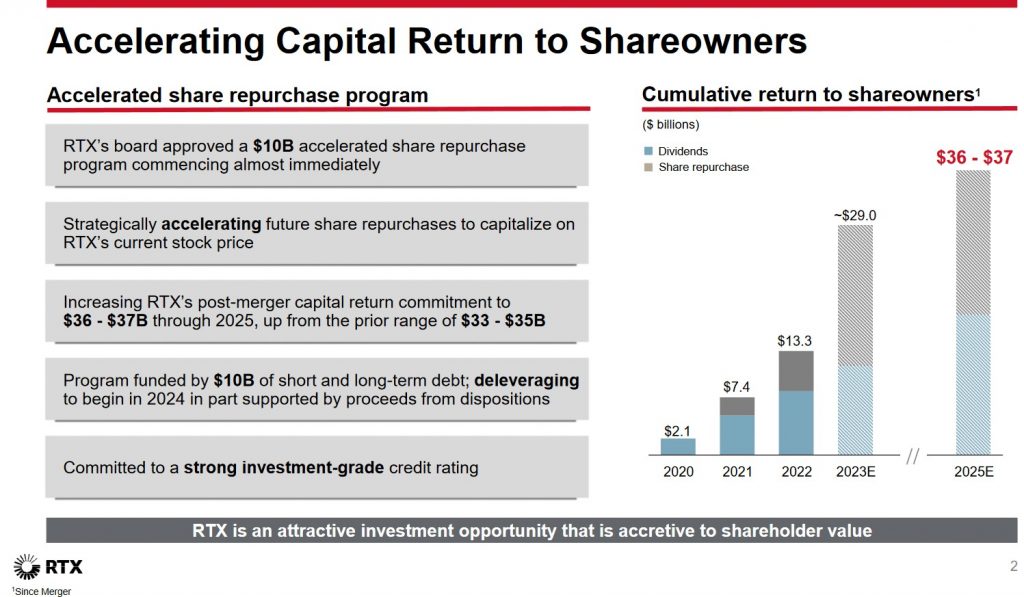
Source: RTX - Q3 2023 Earnings Presentation
On October 24, RTX entered into a $10B bridge loan facility, with the proceeds expected to be used to fund the ASR. On the same day, RTX announced its intention to enter into the ASR agreements in October 2023 which will provide for the repurchase of an aggregate of $10B of common stock. Under the ASR, RTX expects to take delivery of the majority of the shares in Q4 2023. The final settlement of the transactions under the ASR agreements is expected to occur no later than Q3 2024. The plan is to repay the bridge loan with long-term debt.
If RTX were to repurchase $10B of shares at an average cost of $79, it would repurchase just shy of 126,585,000 shares. This would lower the weighted average number of issued and outstanding shares to a level that is comparable to FY2020.
Valuation
When I wrote my September 12 post, RTX had not amended its FY2023 adjusted diluted EPS guidance of $4.95 - $5.05. Using my recent $78 purchase price and the $5 mid-point of management's guidance, the forward adjusted diluted PE was ~15.6.
The valuation using broker estimates and my $78 purchase price was:
- FY2023: 19 brokers, mean estimate $5.01, low/high range $4.95 – $5.05. The valuation using the mean estimate is ~15.6.
- FY2024: 21 brokers, mean estimate $5.57, low/high range $4.70 – $5.87. The valuation using the mean estimate is ~14.
- FY2025: 16 brokers, mean estimate $6.65, low/high range $6.25 – $7.20. The valuation using the mean estimate is ~11.7.
With the release of Q3 results on October 24, RTX has amended its FY2023 adjusted diluted EPS of $4.98 - $5.02 from $4.95 - $5.05. With shares having closed at ~$79.15 on October 27, the forward adjusted diluted PE is ~15.85.
The valuation using broker estimates and ~$79.15 is:
- FY2023: 23 brokers, mean estimate $5.01, low/high range $4.93 – $5.05. The valuation using the mean estimate is ~15.8.
- FY2024: 24 brokers, mean estimate $5.49, low/high range $4.70 – $5.90. The valuation using the mean estimate is ~14.4.
- FY2025: 19 brokers, mean estimate $6.47, low/high range $5.92 – $6.95. The valuation using the mean estimate is ~12.2.
I consider a fair value for RTX to be ~$105 - ~$110/share based on current forward-adjusted diluted EPS estimates.
At its June 19, 2023 Investor Day, one of RTX's 2025 commitments was to generate $9B in FCF. With the $10B ASR and further share repurchases in FY2024 and FY2025, it is not unrealistic to expect RTX's weighted average diluted shares outstanding to fall to ~1.3B. On this basis, RTX could generate ~$6.90/share in FCF ($9B/1.3B). If RTX's share price ultimately rises to ~$108, we are looking at a forward P/FCF level of ~15.7 ($108/$6.90). This appears to be a reasonable valuation for a company of RTX's quality.
NOTE: Determining a company's valuation based on future earnings and FCF expectations is not an exact science.
Final Thoughts
My final thoughts are unchanged from my July 29 and September 12 posts.
Although some investors fret when the share prices plunge, we should view pullbacks from a positive perspective. Naturally, this is dependent on owning shares of profitable companies that generate strong free cash flow.
At the time of my most 2 recent RTX posts, I felt shares were trading at a significant discount to intrinsic value. I hoped that RTX's management would be of a similar opinion and would ramp up the share repurchase component of the company's capital allocation. Fortunately, this has materialized.
The current market conditions are such that I do not envision the $10B ASR having much of an impact on RTX's share price in the short term. When market conditions improve, I expect investors will start to look upon RTX more favourably. I am, therefore, of the opinion that investors should capitalize on RTX's significant undervaluation before shares eventually retrace to intrinsic value.
I wish you much success on your journey to financial freedom!
Note: Please send any feedback, corrections, or questions to [email protected].
Disclosure: I am long RTX.
Disclaimer: I do not know your circumstances and am not providing individualized advice or recommendations. I encourage you not to make investment decisions without conducting your research and due diligence. You should also consult your financial advisor about your specific situation.
I wrote this article myself and it expresses my own opinions. I am not receiving compensation for it and have no business relationship with any company whose stock is mentioned in this article.


